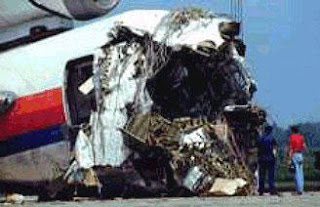Former Marine Al Haynes had the controls of United Airlines 232 out of Denver heading for Chicago when he and first engineer and flight engineer heard an explosion – the tail engine had blown. "Shrapnel had sliced the main and backup hydraulic control lines through which the pilots operated the rudder, ailerons, and wing flaps." The pilots could not fly the plane and seemingly could not land.
 |
| Tail section of the DC-10 after UA-232 crashed July 10,, 1989. |
Fortunately for the crew and passengers (185 people in all), United pilot trainer Denny Fitch happened to be aboard. He offered his help: "Tell me what you want, and I'll help you." Captain Haynes welcomed his and others' input: "Anybody have any ideas?" The team communicated in short bursts, called notifications.
The open, honest communication and willingness to express vulnerability built a team able to tackle the unbelievable challenge they faced. "They chose routes, calculated descent rates, prepared for evacuation, and even cracked jokes." Through it all, Captain Haynes remained calm and cool.
As they attempted to land Flight 232, "A wingtip dipped and dug into the runway, sending the plane into a fiery cartwheel. The crash was terrible, but 185 people survived, including the entire crew. Some walked out of the wreckage into a cornfield. The survival of so many passengers was termed a miracle."
 This chicken-skin true story of an event that occurred nearly 30 years ago is one of several great stories and numerous examples presented in "The Culture Code: The Secrets of Highly Successful Groups" by Daniel Coyle (Bantam Books, 2018). The stories reinforce Coyle's points.
This chicken-skin true story of an event that occurred nearly 30 years ago is one of several great stories and numerous examples presented in "The Culture Code: The Secrets of Highly Successful Groups" by Daniel Coyle (Bantam Books, 2018). The stories reinforce Coyle's points."What matters is telling the story. We tend to use the word 'story' casually, as if stories and narratives were ephemeral decorations for some unchanging underlying reality. The deeper neurological truth is that stories do not cloak reality but create it, triggering cascades of perception and motivation. The proof is in brain scans: When we hear a fact, a few isolated areas of our brain light up, translating words and meanings. When we hear a story, however, our brain lights up like Las Vegas, tracing the chains of cause, effect, and meaning. Stories are not just stories, they are the best invention ever created for delivering mental models that drive behavior."Coyle's great examples and the quality of his storytelling show not only how one person can make a difference, but also how a group can come together to excel. He discovers and shares how to foster trust, keep people close, make connections and build belonging in a group. He reveals why it's important for leaders to be humble, honest, gracious and good listeners.
Examples include NBA coach Greg Popovich of the San Antonio Spurs and NCAA coaches John Wooden (UCLA) and Mike Krzyzewski (Duke). Coyle references former USS Benfold CO Michael Abrashoff, author of "It's Your Ship," who made a concerted effort to listen to every crew member and get their perspectives and suggestions. We are reminded of the Johnson & Johnson Tylenol crisis and how a corporation responded correctly to a crisis by sticking to its credo to always do the right thing: Core values.
 |
| Coach Greg Popovich (second row, second from left) and San Antonio Spurs visit with staff and Wounded Warriors at Brooke Army Hospital, Oct. 21, 2015. |
The missileers "are part of a system designed in the late 1940s by General Curtis LeMay, a larger-than-life figure..." Coyle rolls out a litany of failures over the past decade-plus. "Everyone agrees that missileer culture is broken," he writes.
"It's useful to contrast the missileers' dysfunctional culture with that of their navy counterparts who work in nuclear submarines. At first glance, the two groups seem roughly similar: Both spend vast amounts of time isolated from the rest of society, both are tasked with memorizing and executing tedious protocols, and both are oriented toward Cold War nuclear deterrence missions whose time has passed. Where they differ, however, is in the density of the belonging cues in their respective environments. Sailors in submarines have close physical proximity, take cpart in purposeful activity (global patrols that include missions beyond deterrence), and are part of a career pathway that can lead to the highest positions in the navy. Perhaps as a result, the nuclear submarine fleet has thus far mostly avoided the kinds of problems that plague the missileers, and in many cases have developed high-performing cultures."Leaders must understand the importance of trust and proximity to achieve group cohesion, creativity and toughness. Good organizations value their history, heritage and artifacts.
 |
| SEAL training in TRIDENT 18-4 July 7. (Photo bySSgt Corban Lundborg) |
This book is filled with military and civilian stories of how to build and maintain a team in order to meet a mission.
 |
| WWII veterans of USS Indiana (BB 58) salute at commissioning of Navy's 16th Virginia-Class fast-attack submarine USS Indiana (SSN 789), Sept. 29. |
No comments:
Post a Comment